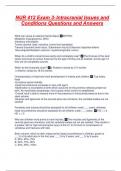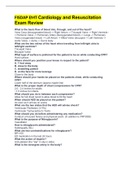NUR 412 Exam 3- Intracranial Issues and
Conditions Questions and Answers
What can cause an altered mental status ✅MITTEN:
Metabolic (hypoglycemia, DKA)
Infections (meningitis)
Toxins (alcohol, lead, narcotics, toxins from parasites)
Trauma (traumatic brain injury, Submersion injury) Endocrine (hypothyroidism)
Neurological/Neoplasm (seizure, myelomenigocele, tumor)
When do a child's cranial bones ossify and completely fuse? ✅The 8 bones of the skull
ossify and close at various times but by the age of 8 they are all ossified, and by age 12
they are all completely sutured.
When do the fontanels close? ✅o Posterior closes by 2-4 months
o Anterior closes by 18-24 months
Characteristics of head and neck development in infants and children ✅-Top heavy
head
-Excessive spinal mobility
-Head circumference increases in size until age 5
-Myelination is incomplete at birth which accounts for the primitive reflexes present at
birth. As myelination progresses, fine & gross motor control is established.
-Cranial vault is able to expand more in the presence of intracranial pressure due to the
open sutures
-Muscles and ligaments of the cervical spine are immature, the veritable bodies are not
ossified
Fontanels and sutures should be assessed for all children under ___ years, whereas
head circumference should be assessed for all children under ___ years. ✅F/S = < 2
HC = < 5
Why are children more prone to neck injuries. ✅The muscles and ligaments of the
cervical spine are immature, and the vertebral bodies are not yet ossified. This results in
a greater risk for high cervical spine injury at the C1 to C2 level or compression of
vertebrae and fractures with falls
Brain volume, which is often measured by head circumference in children, grows to
___% of its adult size in the first year, ___% by 3 years, and ___% by 6 years.
A. 25%, 50%, 75%
B. 50%, 75%, 90%
C. 50%, 90%, 100%
,D. 30%, 50%, 75% ✅B.
50% (Age 1)
75% (Age 3)
90% (Age 6)
How much blood does the brain use in comparison with the rest of the body? ✅10x
more, 17% of the bodies cardiac output
Autoregulation ✅The unique ability of the cerebral arterial vessels to change their
diameter in response to fluctuating cerebral perfusion pressure or CPP (the pressure at
which the cells are perfused). This allows the brain to continue recieving constant blood
flow even in the presence of fluctuating BP and perfusion caused by body
posture,increased intracranial pressure, decreased cardiac output or narrowing or
occlusion in the major blood vessels of the neck.
-Autoregulation fails when blood vessels can dilate no further or ICP has increased too
much.
What causes ICP ✅So too much blood due to a hemorrhage, too much tissue due to
tumor or swelling, too much CSF due to hydrocephalus, will increase intracranial
pressure!
Reduced cerebral perfusion due to ICP results in: ✅ischemia, nausea, fainting,
dizziness, dim vision
-The MAP falls causing hypotension
Hypercapnia (increased CO2) ✅Increased levels of lactic acid, which causes dilation
of cerebral blood vessels resulting in increased blood flow and blood volume, thus also
increasing ICP due to the 80 10 10 rule.
-Brain is very sensitive to this and the metabolic damage to the brain tissue caused by
an inadequate supply of well oxygenated blood can often exceed the effects of the
trauma itself.
Hypocapnia ✅Constricts cerebral blood vessels (Vasoconstriction) and decreased
blood flow
Hyperthermia ✅increases the need for oxygen by the brain
Hypothermia ✅decreases the need for oxygen by the brain
Increased Intracranial Pressure (ICP) ✅defined as the total pressure exerted by the
brain, blood, and CSF in the intracranial vault. When one of these components
increase, another one must decrease to keep the total volume the same; the blood
and/or CSF are the only two that can do this because the brain is a fixed amount. CSF
can compensate by decreasing production and/or increasing absorption of CSF
,-Brain 80%
-Blood 10%
-CSF 10%
Causes of ICP include: ✅This is a MEDICAL EMERGENCY!!
-Trauma
-Lesions
-Hydrocephalus
-Meningitis
-DKA
-Hypoxic-ischemic injury
-Status epilepticus
-Aneurysm
-Stroke
Signs and symptoms of ICP in infants ✅-vomiting
-Slight change in vital signs
-Sunset eyes (white sclera above eyes)
-Seizures
-Restlessness, irritability
-papilledema (optic disk swelling)
-Changes in respiratory patterns
-Poor feeding
SIGNS SPECIFIC TO INFANTS
-Poor feeding
-Bulging fontanel
-Wide sutures
-MacEwen (Cracked pot): occurs when ICP has caused the sutures to separate forming
a cracked pot resemblance
-increased head circumference
-Dilated scalp veins
-High-pitched cat-like cry
Which of the following is a clinical manifestation of increased intracranial pressure in
infants?
A. Irritability
B. Photophobia
C. Vomiting and diarrhea
D. Pulsating anterior fontanel ✅A. Irritability
Signs and Symptoms of ICP in children ✅-Nausea and vomiting
-Slight change in vital signs
-Sunset eyes
-Seizures
-Restlessness, irritability
, -Papilledema
-Changes in respiratory patterns
SIGNS SPECIFIC TO CHILDREN:
-Visual disturbances, diplopia
-Dizziness or vertigo
-Headache
-Slurred speech
What three factors regulate intracranial pressure? ✅Blood, CSF, Brain
(True/false) Increased intracranial pressure is a life-threatening emergency. ✅TRUE
Which of the following is a clinical manifestation of increased ICP in children?
A. Low-pitched cry
B. Sunken fontanel
C. Diplopia, blurred vision
D. Increased blood pressure ✅C. Diplopia, blurred vision
Late signs of ICP ✅-Significant decrease in LOC: Decrease motor response to
command, decreased sensory response to painful stimuli.
-Cushing's Triad
-Fixed and dilated pupils
Cushing's Triad presents with what three manifestations? ✅Widened pulse pressure
(HTN)
Bradycardia
Respiratory depression
* Late sign of impending brainstem herniation
Nursing interventions for ICP: ✅**Early recognition is key
•Decrease cerebral blood volume
•Decrease metabolic rate
•Decrease CSF volume
•Maintain cerebral perfusion pressure
-Oxygenate: Intubate and ventilate
-IV fluids: To help with blood pressure
-Drugs: Epi and isotropes, Mannitol/Lasix, Anticonvulsants
-Extra ventricular drain
-Head midline and HOB 15 to 30 degrees
-Decrease metabolic rate





